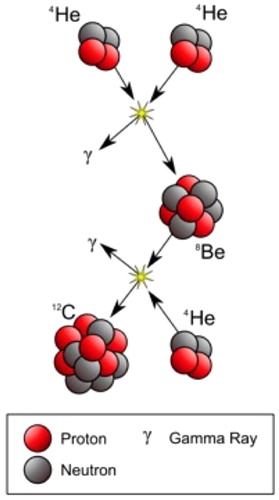ABSTRACT
We perceive a world of great diversity but numerous things are composed of about a hundred different chemical elements, among them are hydrogen, carbon, nitrogen, oxygen, iron, and uranium. These elements are combined with one another in a multitude of ways to produce complexity of all objects. However, there are only three nucleosynthetic astrophysical sites: (i) big bang nucleosynthesis, where hydrogen and helium are produced; (ii) stars, where all elements from carbon to uranium are synthesized and (iii) interstellar medium in galaxies where lithium (a part of), beryllium and boron are made by non-thermal collisions between cosmic rays and interstellar matter. The origin of the atoms is now well understood. It is one of the greatest astrophysical discovery in the twentieth century. All the elements in the Mendeleev table, and specifically the atoms of life: carbon, nitrogen and oxygen, come from the work of all generations of stars in galaxies. Presently, after 13.8 Gyr, atomic matter in the universe is composed of 70% hydrogen, 28% helium and only about 2% by mass, of all the other elements. Complex (and also some specific light) atoms are rare in the Universe.
1. Matter in the universe
From matter of the chemists to matter of the astrophysicists. Three sites of nucleosynthesis (synthesis of the nuclei of atoms).
The well-known Mendeleev table of elements is displayed in Figure . It exhibits the diversity of atoms. In addition, Figure shows quantitatively the abundance of elements in the solar system with respect to their atomic number (number of protons).
Figure 1. The well-known Mendeleev table corresponds to the matter of chemists. All chemical elements are included in this table, from hydrogen to heavy elements such as uranium. Heavier elements that are also shown have been synthesized in the laboratory. A box defines an element, it is characterized by the number of protons in the nucleus of the atom, Z. (Copyright, Ministère de la Recherche, France).
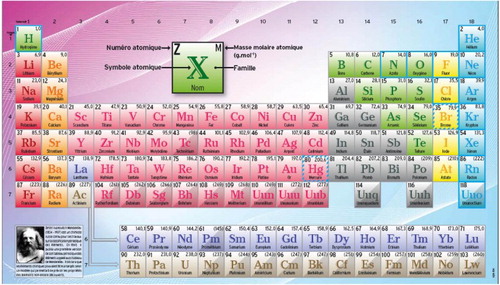
Figure 2. Astrophysical matter in the Universe. The abundances (normalized to hydrogen) are displayed with respect to the atomic number Z (number of protons).There are three astrophysical sites for nucleosynthesis (arrows);hydrogen and helium from big bang, carbon to uranium from stars and lithium, beryllium and boron from collisional processes between cosmic rays and interstellar matter, so-called spallative nucleosynthesis. Uranium is the least abundant element in the solar system.
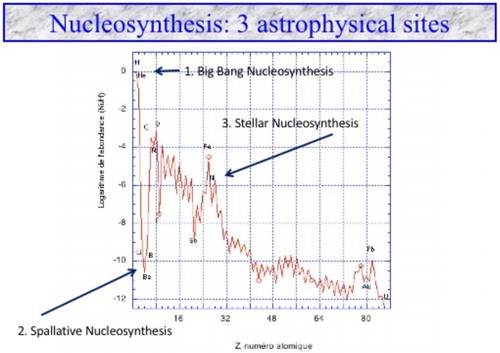
In general, the more complex is an atom, the less abundant it is. Moreover, nuclei with even number of protons are more abundant than odd ones. More generally, even–even nuclei (with even number of protons and even number of neutrons) are more frequent than even–odd elements that are in turn more common than odd–odd ones. This is due to the additional stability offered by pairing of protons on the one side and neutrons on the other side.
Indeed, a lone nucleon, affected by a lack of bonding, destabilizes its environment. This is reflected by the binding energy per nucleon which is higher for even–even nuclei. The spikes in Figure show clearly this trend. Note that iron nucleus has the highest binding energy per nucleon, this is why it is relatively abundant (peak in Figure ). Based on this trend, we will describe the origin and evolution of atomic matter in the Universe.
In Sections 2 and 3, we present a brief overview of the big bang theory and baryogenesis (genesis of protons and neutrons), Sections 4 and 5 will be devoted to the big bang nucleosynthesis (BBN) and non-thermal nucleosynthesis, respectively. In Section 6, we describe the nucleosynthesis in stars and the cosmic evolution of matter in the Universe. We conclude in Section 7.
2. The big bang theory
Atoms are rare in the Universe, ordinary matter represents only 5% of the total substance of the Universe. 95% (dark matter and dark energy) content of the cosmos is unknown.
There are presently three observational evidence (pillars) in favor of the big bang model: (i) the expansion of the Universe, the galaxies fly apart according to the Hubble law, H is the Hubble constant (67.5 km/s and by Megaparsec, a parsec corresponding to km): the expansion speed v is proportional to the distance between galaxies, D (
) (Figure ), (ii) the Cosmic Microwave Background (CMB) radiation, the fossil photons are set free when the Universe became transparent to its own light. They are present in the whole Universe but, because of the expansion, have cooled down to a temperature of 2.73 K. These two pillars are observational. (iii) Primordial or BBN is a theoretical one but firmly established, which reproduces the abundance of cosmological light chemical elements over 9 orders of magnitude (Coc et al. Citation2014, Citation2015).
Figure 3. The law of Hubble is the first pillar of the big bang theory. It corresponds to the fact that relative velocities between galaxies are proportional to their distance. This is interpreted as a direct observation of the expansion of the Universe.
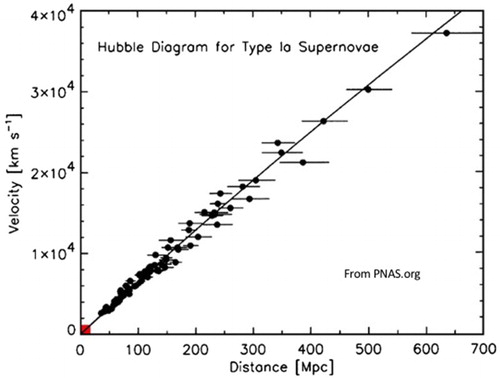
The study of the beginning and the evolution of the Universe is one of the most fascinating subjects in modern cosmology. This section provides a brief overview of the early Universe.
The Universe was born in a ‘big bang’ at a moment when the density and the temperature were (almost) infinite, in the most symmetric state. At that time, all fundamental physical forces such as gravitational, electromagnetic, strong and weak ones were united. Due to the rapid expansion of the Universe (the first pillar), the temperature dropped quickly, and the fundamental forces were separated. At about second after the big bang, the Universe went through a very short and rapid expansion called inflation, during the time range,
second, the dimension of the Universe was multiplied by an enormous factor of at least
, even to
, due to probably the separation of the strong interaction. Cosmic inflation is thought to be responsible for the remarkable degree of homogeneity seen in the present Universe at a large scale, and at the same time of the structure formation in the Universe. On the one hand, inflation stretched space and eliminated its defects and on the other hand, the quantum fluctuation of the inflation (the field that drives inflation) led to the seeds of galaxies.
A few minutes later, atomic nuclei started to form. Then protons and neutrons began to combine into atomic nuclei producing hydrogen, helium and a trace of lithium. BBN lasted until the temperature and density of baryons (baryons correspond to normal matter, protons and neutrons) became too low for further nucleosynthesis. The elements necessary for life, such as carbon and oxygen, had not been formed at this moment.
After inflation and primordial nucleosynthesis, not much change occurred for the next hundred thousand years or so. The Universe continued to expand, gradually cooling off until its temperature fell to a few thousand Kelvin. At that point, its density was only g/cm3, on average.
At that time the electrons were captured by hydrogen and helium nuclei, forming a gas of electrically neutral atoms. Prior to this moment, the Universe was a plasma. A plasma is a physical state of matter where protons, photons, and electrons are not formed as atoms but are strongly interacting.
So, about 380, 000 years after the big bang, the Universe cooled below 3000–4000 K. The photons decoupled from matter and streamed freely. This radiation, the CMB, was first detected by A. Penzias and R. Wilson in 1964. They won the Nobel Price in 1978. In 1989, the COBE mission had observed CMB in great details (Figure ) and another Nobel Prize in 2006 was awarded to J. Mather and G. Smoot (Smoot Citation2000) for the discovery of the anisotropy of the CMB radiation.
Figure 4. This is the CMB pillar of the big bang theory. Data points come from the COBE satellite.The black body curve predicted by the big bang theory (curve) and that observed in the CMB (points) are perfectly superposable.
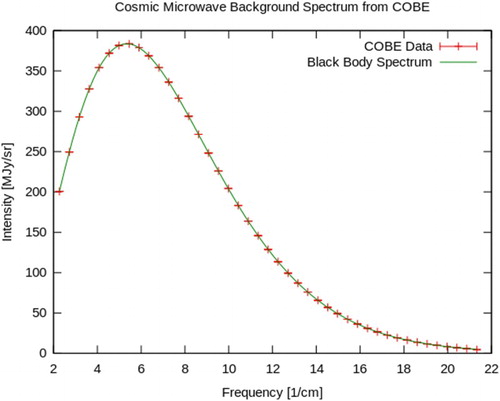
More recently, observational CMB results from the two satellites Wilkinson Microwave Anisotropy Probe (WMAP) and Planck confirm inflationary cosmology and determined the cosmological parameters with an unprecedented precision (Ade et al. Citation2016; Hinshaw et al. Citation2013). The small temperature/density variations detected on the sky map are the ‘seeds’ that will grow into the galaxies and galaxy clusters seen in the present Universe. These successful experiments lead to conclude that the Universe contains about only 4.9% of baryons (atoms), 26.6% of dark matter and 68.4% of dark energy. Dark matter and dark energy have opposed gravitational effects. Dark matter has an attractive gravitational effect, whereas dark energy has a repulsive (anti-gravitational) one. The precise proportions of the different cosmic ingredients are shown in Figure . The intrinsic properties of dark matter and dark energy remain poorly understood. Anyway, inflationary models, the expansion of the Universe, the CMB and BBN are the foundation of modern cosmology. The history of the Universe from the inflation up to now is depicted in Figure .
Figure 5. Content of the Universe. Critical density () of the Universe corresponds to the value predicted by the theory of inflation. Atoms represent only 4.9% of the Universe content. Among them the visible atoms (gas and galaxies) are even more rare (0.003). Most of baryons (hydrogen and helium) stay in the intergalactic medium. Fossil photons (CMB) represent a tiny fraction of the energy density of the Universe though being abundant.
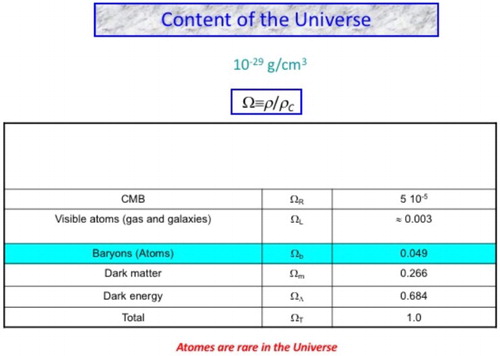
Figure 6. Cosmic timeline. Evolution of cosmic structure from the big bang up to now. After the dark ages, the first stars appeared about 400 millions years after the big bang and then galaxies started to develop. Recent observations suggest that the expansion of the Universe is accelerating due to dark energy. (Credit: NASA/WMAP Science Team).
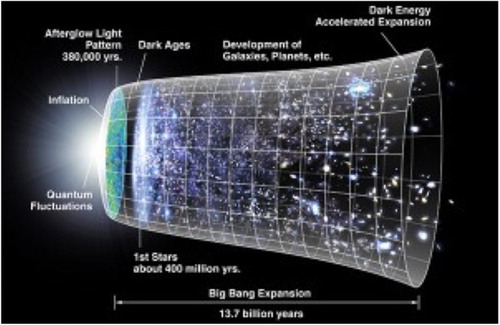
The Universe then entered the cosmic dark ages because there were no stars and no light from stars. Only hydrogen and helium clouds were present at that time. A few hundred million years after the big bang, matter collapsed into minihalos which became the birth sites for the first stars since they provided gravitational wells that retained gas to form stars. The light from the first stars ended the dark ages. These first stars forged the first complex nuclei as carbon and oxygen. Thus, they play a crucial role in the global evolution of the Universe.
To summarize, at the beginning, all space and time, all energy and matter emerged from symmetric conditions that we can guess today only in abstract equations. The history of the Universe from this earliest instant has been a saga of ever-growing asymmetry and increasing complexity. As space expanded and Universe cooled, particles began aggregating and structures started forming from this ultrahot plasma. Eventually clusters and galaxies, stars, planets and even life itself emerged. In at least one corner of the cosmos where conditions were ideal, intelligent beings evolved to the point where they could begin to comprehend these fantastic origins. Above all, from the big bang on, the Universe is continuously evolving.
3. Baryogenesis
Due to matter/antimatter asymmetry ( protons compared to
antiprotons), only one proton for
photons remained after annihilation.
The theoretical prediction of antimatter made by Paul Dirac in 1931 is one of the most impressive discoveries (Dirac Citation1934). Antimatter is made of antiparticles that have the same (e.g. mass) or opposite (e.g. electric charge) characteristics but that annihilate with particles, leaving out at the end mostly photons. A symmetry between matter and antimatter led him to suggest that ‘maybe there exists a completely new Universe made of antimatter’. Now we know that antimatter exists but that there are very few antiparticles in the Universe. So, antiprotons (an antiproton is a proton but with a negative electric charge) are too rare to make any macroscopic objects.
In this context, the challenge is to explain why antimatter is so rare (almost absent) in the observable Universe.
Baryogenesis (i.e. the generation of protons and neutrons AND the elimination of their corresponding antiparticles) implying the emergence of the hydrogen nuclei is central to cosmology. Unfortunately, the problem is essentially unsolved and only general conditions of baryogenesis were well posed by A. Sakharov a long time ago (Sakharov Citation1979).
Baryogenesis requires at least departure from thermal equilibrium, and the breaking of some fundamental symmetries, leading to a strong observed matter–antimatter asymmetry at the level of 1 proton per 1 billion of photons.
Mechanisms for the generation of the matter–antimatter strongly depend on the reheating temperature at the end of inflation, the maximal temperature reached in the early Universe. Forthcoming results from the Large Hadronic Collisionner (LHC) at CERN in Geneva, BABAR collaboration, astrophysical observations and the Planck satellite mission will significantly constrain baryogenesis and thereby provide valuable information about the very early hot Universe.
4. Big bang nucleosynthesis
There are a few atoms per unit volume in the Universe, only a few g/cm3 on average. Moreover there are only five atoms of lithium-7 synthesized for
atoms of hydrogen.
In the standard big bang cosmology, none of the chemical elements existed from the very beginning. Three were synthesized during the first minutes by nuclear reactions. About one second after the big bang, the Universe had expanded and cooled to the point where nuclear physics plays its role. The individual protons and neutrons in the primordial soup started sticking together to make heavier, more complex nuclei. Before that moment it was just too hot, with a temperature that exceeded 10 billion Kelvin, about a million times hotter than the surface of the Sun today.
In a short period called the ‘Era of Nucleosynthesis’, the Universe became a thermonuclear reactor where nuclei of the lightest elements did form. All present hydrogen and deuterium, almost all present helium and a very few lithium (but a significant fraction of the present day ones) were created. The remnants of these light elements that are detectable today in the cosmos give us an important information about those early conditions and prove that our Universe indeed began in a very hot, condensed state. They can also be used to make a good estimate of the average density of normal matter today.
Just before to the Era of Nucleosynthesis and after the baryogenesis phase, the Universe was a hot soup of mostly electrons and positrons, photons and neutrinos. However, for every proton or neutron, there were at least a billion photons. The conditions of the Universe, say the kinetic energies of particles, during this epoch was not too different from those studied here on Earth by nuclear physicists, so its primordial evolution is well understood. We have the greatest confidence that we can make valid statements about the cosmology of this epoch based on our knowledge of nuclear physics.
Let us give a closer look.
A key to understand the physics of this period is the concept of thermal equilibrium. This phenomenon represents a state of balance between opposing nuclear reactions. When a system is in thermal equilibrium, its temperature alone determines the relative quantities of the different interacting species, here nuclei, that are present. When the Universe was in thermal equilibrium its temperature governed the ratio of neutrons to protons, n/p.
Before one second, the temperature was above ten billions kelvin, the number of neutrons and protons were roughly equal, because these particles of about the same mass were easily converted into each other. After ten seconds, the temperature had fallen to three billions kelvin, and the reactions producing neutrons from protons were slowing down and the ratio n/p had fallen to 1/6. As the Universe kept expanding and cooling, n/p continued to drop because of neutron decay. So after about two hundred seconds, it was only 1/7.
This is when the temperature of the Universe had dropped to the point where proton and neutron merged together to form a deuterium nucleus D, which is the heavy isotope of hydrogen, the starting point of further nucleosynthesis.
Then, two neutrons plus a proton made a nucleus of tritium, two protons plus a neutron made He or two protons and two neutrons made
He, the most stable of nucleus of all the light element is
He.
Figure presents the nuclear network of BBN. There are 12 nuclear reactions which are responsible for the production of these elements via thermonuclear fusion.
Figure 7. Network of nuclear reactions involved in BBN. There are 12 nuclear reactions responsible for the production of hydrogen, helium and lithium.
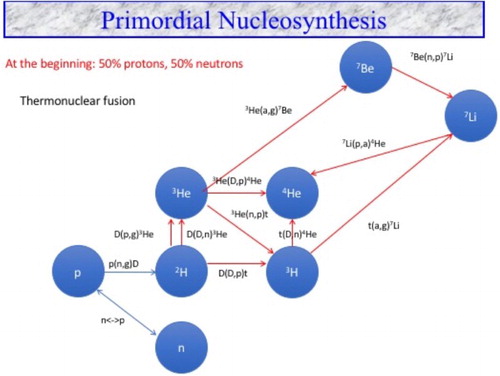
At the end of BBN, essentially all the baryons in the Universe existed either freely as single protons or were trapped inside of He nuclei. Some tiny residues of deuterium D, tritium and
He remained, along with a trace of
Li, which has three protons and four neutrons in its nucleus (for a review, see Fields et al. Citation2016).
Figure displays the evolution of the different species (from H to Li) and temperature as a function of time. One sees that the abundances are stabilized after 10,000 seconds or below Kelvin.
Figure 8. Evolution of the mass fraction of light isotopes ( hydrogen, deuterium, helium and lithium as a function of time (in seconds). The synthesis of these isotopes stops at about seconds. Lithium is extremely rare, 1 for 10 billions compared to hydrogen, (from Coc et al. Citation2015).
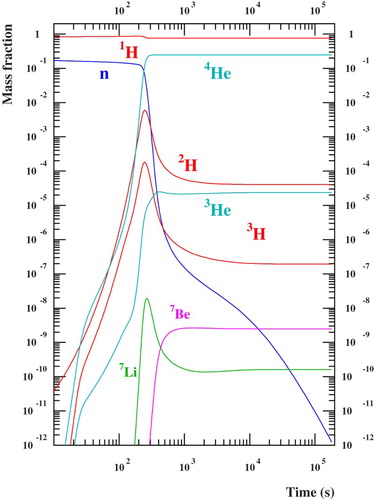
The final primordial abundances, normalized to hydrogen, H, are the following (Coc et al. Citation2015):
Traditionally helium is expressed in mass fraction, so,
On the observational side, to derive the most primitive abundances of these elements, one has to extract them from observations of astrophysical sites which are thought to be nonevolved and primitive.
Deuterium is a very fragile isotope (since it is an odd–odd nucleus), easily destroyed in stars. Its most primitive abundance is determined from the observation of clouds present on the line of sight of distant quasars (very distant primeval galaxies) (see Cooke et al. Citation2014, Citation2016, Citation2017). Deuterium is only produced during the BBN. Consequently, it is a very good cosmological tracer.
He is produced in BBN and by stars. Its primitive abundance is deduced from observations in ionized hydrogen regions of compact blue galaxies, rather primitive.
He mass fraction is obtained from the extrapolation to zero metallicity (in astrophysics, metallicity represents all elements heavier than helium) (see Aver et al. Citation2013, Citation2015).
The primitive lithium abundance is deduced from observations of low metallicity stars in the halo of our Galaxy where the lithium abundance is almost independent of metallicity (Spite and Spite Citation1982). This Li abundance is interpreted as corresponding to the BBN
Li yield.
So, astronomical observations lead to: (Cooke et al. Citation2017),
(Sbordone et al. Citation2010). Helium, in mass fraction,
(Aver et al. Citation2015)
There is a global agreement over a range of nine orders of magnitude between spectroscopic observations and theoretical values deduced from CMB data. However, regarding lithium (Figures and ), there is a discrepancy by of a factor of ∼3–5. The theoretical abundance is larger than the observational one. Many studies are been devoted to this so-called ‘lithium problem’. At the present time, this discrepancy is not explained.
Figure 9. Abundances of the cosmological elements as a function of the ratio baryons/photons, η, for three neutrino families. The vertical areas correspond (i) to the CMB baryonic density observations coming from satellites WMAP (dot) and Planck (solid). The horizontal areas (hatched and dotted lines) represent the different adopted observational abundances. The dash-dotted lines correspond to He calculated with a different value of the number of neutrino families derived from the Planck mission (from Coc et al. Citation2014).
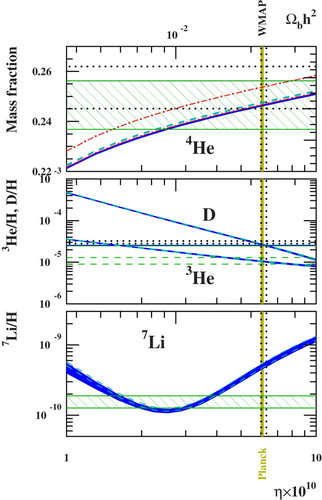
Figure 10. Li/H of old stars in the galactic halo as a function of [Fe/H] (bottom scale, which is referred to the solar abundance, 0 corresponds to the solar value, corresponds to 1/1000 of the solar value etc., astrophysical conventions :
of the star – log(Fe/H) of sun). The time scale is also shown, note that these stars are very old (about 12–13 Gyrs old). Primitive lithium abundance is deduced from observations of low metallicity stars (black points) in the halo of our Galaxy. There is a discrepancy (about a factor 3 to 5) between the value deduced from these observed spectroscopic abundances and the one calculated (horizontal line).
![Figure 10. Li/H of old stars in the galactic halo as a function of [Fe/H] (bottom scale, which is referred to the solar abundance, 0 corresponds to the solar value, corresponds to 1/1000 of the solar value etc., astrophysical conventions : of the star – log(Fe/H) of sun). The time scale is also shown, note that these stars are very old (about 12–13 Gyrs old). Primitive lithium abundance is deduced from observations of low metallicity stars (black points) in the halo of our Galaxy. There is a discrepancy (about a factor 3 to 5) between the value deduced from these observed spectroscopic abundances and the one calculated (horizontal line).](/cms/asset/3b3a48d6-1021-4347-90e5-4ee86a8642a5/tfls_a_1411838_f0010_c.jpg)
Even though the direct detection of primordial CNO isotopes seems highly unlikely with the present observational techniques, it is important to better estimate their BBN production. The value of the initial CNO abundance is estimated to be as low as (in number of atoms relative to hydrogen, CNO/H) (Coc et al. Citation2015, Citation2012). This is very low. The astrophysical production site of these elements is clearly stars.
To summarize, BBN predicts the primordial abundances of the light cosmological elements: He, D,
He and
Li that are produced during the first 20 min after the big bang when the Universe was dense and hot enough for nuclear reactions to take place. There is an overall agreement between the calculated and observed abundances, except for the
Li.
Thanks to this BBN calculation we determined the total quantity of atoms in the Universe: only 4.9% of the total cosmological substance. Presently, primordial nucleosynthesis remains an invaluable tool for probing the physics of the early Universe.
5. Collisional nucleosynthesis: origin and evolution of Lithium-Beryllium-Boron
Lithium, Beryllium and Boron are extremely rare in the Universe; only one lithium, one beryllium and one boron atom for about ,
and
hydrogen atoms respectively.
The origin and evolution of the rare elements – Lithium–Beryllium–Boron (LiBeB) – are a crossing point between different astrophysical fields: spectr-oscopy, non-thermal nucleosynthesis, big bang and stellar nucleosynthesis and finally theory of galactic evolution.
Indeed, they are rare because they are fragile and they are destroyed in stars.
A glance to the abundance curve (Figure ) suffices to capture the essence of the problem: a gap separates He and C. At the bottom of this precipice rests the trio LiBeB. They are characterized by the simplicity of their nuclear structure (6–11 nucleons) and their scarcity in the Universe.
Due to the expansion of the Universe, the BBN has stopped at , and primordial thermonuclear fusion has been unable to proceed efficiently beyond lithium and the calculated primordial
Li, Be and B abundances are negligibly small (Figure ).
Figure 11. Abundances by number of atoms relative to H for Li,
Be,
B,
B and
(and uncertainties) as a function of η, baryons/photons ratio. We see that these isotopes are extremely rare at the end of BBN (from Coc et al. Citation2012).
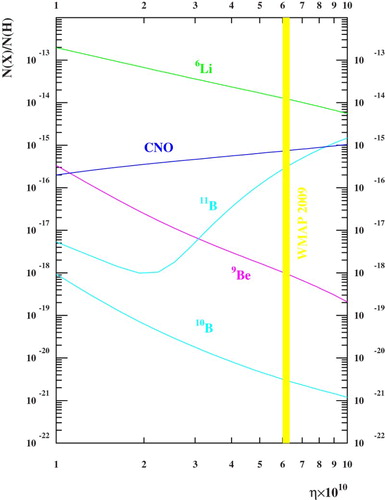
The production and evolution of LiBeB are due to the interaction of Cosmic Rays (CR are composed essentially of very rapid protons which diffuse in the galactic disk) with the interstellar medium (ISM, gas between stars; gas and stars compose a galaxy).
The result of a nuclear collision depends on the composition of the beam (CR) and the target (for example, carbon and oxygen in the ISM), and also on the relative velocity of the projectile and the target nuclei (as it can be the reverse CR vs ISM). Stellar nucleosynthesis implies low energies and high particle densities. In contrast, spallative nucleosynthesis implies high energies (CR) and very low densities (ISM).
The energy required to sustain the CR energy density is mainly supplied by supernovae (SN, exploding massive stars) which are not necessarily the sources of CR nuclei, but their acceleration agents.
Two main LiBeB producers emerge, (i) fast protons interacting with carbon, nitrogen and oxygen (CNO) in the ISM at rest and (ii) fragmentation of CO nuclei in flight on H and He in the ISM. Massive stars are able to furnish freshly synthesized C and O and accelerate them via the shock waves they induce in their surroundings. This mechanism is related to superbubbles (excavated by the winds and explosion of massive stars).
These different mechanisms are included in a global evolutionary model to follow the whole evolution of each element, (for a review see Vangioni Citation2012).
Observations of BeB are shown in Figure taking the iron abundance in stars as an evolutionary index ( corresponding to the iron abundance of the solar system).
Figure 12. Same as Figure , but for Be and B. We note the very low abundance of these elements compared to hydrogen (between to
).
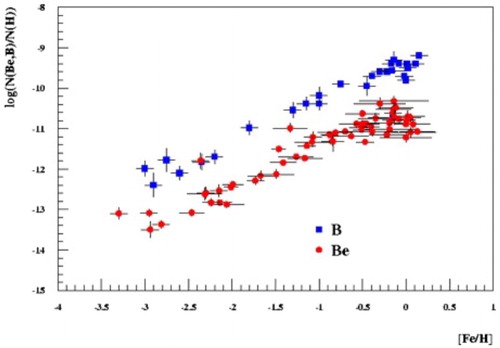
To summarize, LiBeB are exceptional since they are both simple and rare. Typically, in the Solar System:
whereas carbon and oxygen are
and
. As shown in the following, stellar nucleosynthesis forge the whole variety of nuclei from carbon to uranium.
6. Nucleosynthesis in stars and cosmic evolution
Stars are the agents of complexification of matter. After 13.8 Gyr and many successive generations of stars in galaxies, complex elements (from carbon to uranium) represent only about 2 % of atoms by mass.
Another frontier of modern cosmology is understanding the end of the cosmic dark ages, when the first luminous objects (stars and galaxies) reshaped the primordial Universe into the current Universe. The advancement of supercomputing power in the last decade has allowed us to start investigating the formation of the first stars by modelling the relevant physical processes. The first star formation scenarios suggest that they could have been massive, with a typical mass range of about 40–100 solar masses ( g). Some of them died in energetic SN explosions. These first SN have dumped considerable energy and spread some complex elements to the interstellar medium.
The formation of the first stars transformed the simple early Universe into a highly complicated one. The first stars made from the hydrogen and helium left from the big bang are called the Population III (Pop III) stars. They are rare, massive, with a short lifetime (a few millions years old).
At present time, there is no direct detection of Pop III stars. Nevertheless, the observation of present-day stars may provide us hints to study the Pop III star formation in the past (Vangioni-Flam et al. Citation2000).
The standard cosmological model offers a fundamental theory for the large-scale formation and suggests that the cosmic structure has formed in a hierarchical manner. So, the first generation of small galaxies was likely well in place 400 millions years after the big bang. Galaxies began then a phase of merging and coalescence with other galaxies, whereby they built up from masses of several millions solar masses to hundred billions of solar masses.
Complexification of matter takes place in stars, generations after generations.
So, all the heavy elements – as carbon, nitrogen, oxygen, silicon, aluminum, copper and iron – were formed afterwards by thermonuclear fusion in the core of stars.
In a galaxy 90% of stars are like our Sun or less massive, the other 10% being more massive. Low mass stars like our Sun cook hydrogen nuclei to make helium nuclei and then transform helium nuclei into C and N. This elaborated matter is dispersed into the ISM through the so-called planetary nebula phase.
The more massive and less numerous ones, having exhausted their hydrogen, burn helium to make carbon, oxygen and a host of heavier elements. These elements are spewed into space by stellar explosions, supernovae, like SN1987a that appeared in the Large Magellanic Cloud on 23 February 1987 (Figure ).
Figure 13. Supernova SN87a in the Large Magellanic Cloud (a satellite galaxy of the Milky Way located at 163 000 light years) has been observed in 1987 with all available detectors and telescopes (bottom before explosion, above after explosion). This is really the modern time supernova. This observation, in agreement with theoretical models of explosive nucleosynthesis, has strengthened our confidence in them, specifically concerning the synthesis of iron. (Copyright Anglo Australian Observatory).
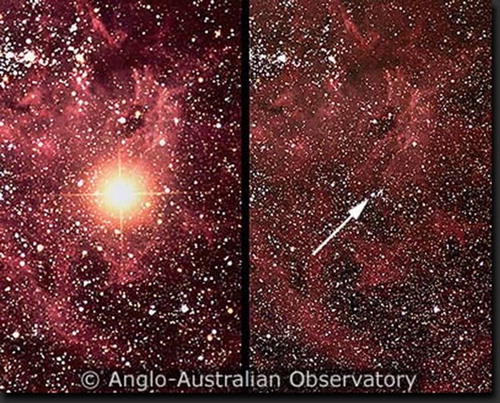
Note that the most heavy elements (with atomic numbers higher than iron) are the rarest (see Figure ). To synthesize these elements, we identify three processes and three categories. (For a review see Arnould et al. Citation2007.) Indeed, three different mechanisms s, r, and p processes are called for to account for the production of these three types of stable elements, rapid capture of neutrons (r) slow capture of neutrons (s) and capture of protons (p). The first process corresponds to rapid neutron captures by heavy nuclei (after iron). These captures must be rapid to undergo radioactive decay. This process occurs in high density of free neutrons as for example a binary neutron star merger. On the other hand, the s process is the other predominant mechanism for the production of heavy elements, it occurs within intermediate mass stars, where the neutron flux is sufficient to cause reactions. Taken together, the r and s processes account for the majority of elements heavier than iron. The third p process can occur in supernova explosions and is proposed to explain the origin of heavy proton-rich elements.
Yet, all the elements heavier than helium make up less than 2% of the visible matter in the Universe, complex nuclei are rare. The other 98% is the primordial hydrogen and helium left over after the BBN phase.
Origin of carbon: three helium nuclei merge to synthesize one carbon nucleus.
The assumption that carbon is built inside stars through thermonuclear fusion of three helium (called α nuclei, 2 protons plus 2 neutrons) nuclei has been proposed by Edwin Salpeter in the early 1950 (Salpeter Citation1952). The triple alpha reaction ( giving
C) is through to operate in red giant stars at a temperature of about 100 millions Kelvin.
Edwin Salpeter showed that a resonant metastable state of Be nucleus enables red giant stars to burn helium to carbon at rather low central temperatures,
Kelvin. Fred Hoyle followed this way with the insight that a new, previously unknown resonance in
C would further increase the amount of carbon from
reaction and, in particular, allows carbon to be produced at the still lower temperature
Kelvin, estimated to be that of red giant stars (Figure ).
As shown in Figure , the excited level of C at 7.65 MeV just above the 7.3667 MeV energy of
, allows rapid enough reactions for carbon to form before the unstable
Be decays (with a the lifetime of
second).
Figure 15. Nuclear levels of carbon and beryllium nuclei and the nuclear chain of carbon synthesis. is the excited level of carbon (from Ekstrom et al. Citation2010).
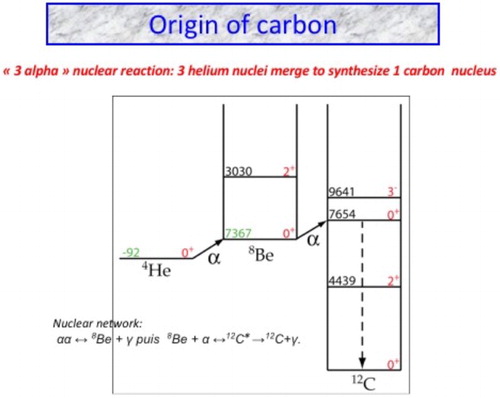
On the other hand, the level of O at 7.1187 MeV lies just below that of
at 7.1616 MeV; if it were higher by just 0.043 MeV, carbon would be quickly destroyed to oxygen.
This episode marked an important milestone in the early development of nuclear astrophysics. Since carbon and oxygen are so important to living molecules, this system is often cited as an example of anthropic fine tuning.
To summarize, freshly synthesized He nuclei coming from hydrogen burning, fuse with protons or other helium nuclei and helium burning can start. A significant amount of
Be builds up in spite of the very short lifetime allowing the addition of a third α particle to produce a stable
C nucleus.
Consequently, these so-called nuclear resonances increase considerably the combination probability of an α particle with a Be to form a carbon. In this context, a fine tuning nuclear situation has permitted the existence of carbon and later of life.
7. Conclusion
Global economy in the cosmos: only 5% of the content of the Universe are atoms, and among them, only 2% are more complex than hydrogen and helium.
During the evolution of galaxies, nucleosynthesis takes place mainly in massive stars which release matter enriched in heavy elements into the interstellar medium when they explode as supernovae (Figure ).
Figure 16. Cosmic evolution of atoms in the Universe. Primitive clouds of gas are composed of hydrogen and helium coming from big bang. Inside them, gravitational contraction induces star formation; the synthesized complex elements are rejected into the interstellar medium through essentially SN explosions.
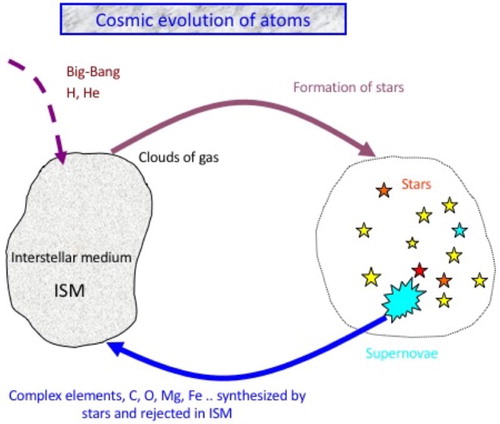
Accordingly, the abundances of heavy elements in the gas increase with time. The observed abundance of metals in stars (formed in the ISM) is an indication of their age: the older, the lower the metallicity.
To conclude, we started from a symmetric state of the Universe, which evolved though symmetry breaking and subsequent complexification. At the starting point, particles and antiparticles were of equal number. Then, due to a slight asymmetry not completely understood, matter exceeded antimatter at the level of one over one billion. At that time, the Universe was bathed with protons, neutrons, electrons, photons and neutrinos.
Then, primordial nucleosynthesis occurred producing mainly hydrogen and helium with a trace of lithium. A long time after (about 400 millions yrs) the first massive stars were born producing the first CNO atoms in small quantities via SN explosions.
The following SN all along the galactic evolution accelerate nuclei which collide with the ISM nuclei and produce the very rare light nuclei LiBeB particularly fragile due to their nuclear structure. It is clear that nuclear physics is the key to the understanding of the evolution of ordinary matter in the Universe.
Carbon is a fascinating nucleus since it is the basis of life and it is the product of an extraordinary energy coincidence at the level of nuclei.
It is stricking that the process of complexification of matter has to overcome these different obstacles; one sees that the result is very inefficient since the present mass fraction of atoms heavier than helium is only about 2% of about 5% of the baryonic matter in the Universe. This shows the extraordinary quality of rarety regarding the ordinary matter.
Even rarer is life since, at least on the Earth, the biomass is only of the order of the mass of our planet!!
Acknowledgments
The authors thank warmly the referee for his/her useful improvements.
Disclosure statement
No potential conflict of interest was reported by the authors.
Additional information
Funding
References
- Ade PAR, Aghanim N, Arnaud M, Ashdown M, Aumont J, Baccigalupi C, Banday AJ, Barreiro RB, Bartlett JG, Bartolo N, et al. 2016. [Planck Collaboration], Planck 2015 results. XVI. Cosmological parameters. Astron Astrophys. 594:A13. doi: 10.1051/0004-6361/201525830
- Arnould M, Goriely S, Takahashi K. 2007. The r-process of stellar nucleosynthesis: astrophysics and nuclear physics achievements and mysteries. Phys Rep. 450:97– 213. doi: 10.1016/j.physrep.2007.06.002
- Aver E, Olive KA, Porter RL, Skillman ED. 2013. The primordial helium abundance from updated emissivities. J Cosmol Astropart Phys. 11:17. doi: 10.1088/1475-7516/2013/11/017
- Aver E, Olive KA, Porter RL, Skillman ED. 2015. The effects of He I λ 10830 on helium abundance determinations. J Cosmol Astropart Phys. 07:11. doi: 10.1088/1475-7516/2015/07/011
- Coc A, Goriely S, Saimpert M, Vangioni E. 2012. Standard big bang nucleosynthesis up to CNO with an improved extended nuclear network. Astrophys J. 744:158. doi: 10.1088/0004-637X/744/2/158
- Coc A, Petitjean P, Uzan JP, Vangioni E, Descouvemont P, Illiadis C, Longland R. 2015. New reaction rates for improved primordial D/H calculation and the cosmic evolution of deuterium. Phys Rev D. 92:123526. doi: 10.1103/PhysRevD.92.123526
- Coc A, Uzan JP, Vangioni E. 2014. Standard big bang nucleosynthesis and primordial CNO abundances after Planck. J Cosmol Astropart Phys. 10:50. doi: 10.1088/1475-7516/2014/10/050
- Cooke RJ, Pettini M, Jorgenson RA, Murphy MT, Steidel CC. 2014. Precision measures of the primordial abundance of deuterium. Astrophys J. 781:31. doi: 10.1088/0004-637X/781/1/31
- Cooke RJ, Pettini M, Nollett KM, Jorgenson RA. 2016. The primordial deuterium abundance of the most metal-poor Damped Lyman-? System. Astrophys J. 830:148. doi: 10.3847/0004-637X/830/2/148
- Cooke R, Pettini M, Steidel CC. 2017. A one percent determination of the primordial deuterium abundance. arXiv: 1710.11129.
- Dirac PA, 1934. Discussion of the infinite distribution of electrons in the theory of the positron. Proc Cambridge Philos Soc. 30:150. doi: 10.1017/S030500410001656X
- Ekstrom S , Coc A, Descouvemont P, Meynet G, Olive KA, Uzan J-P, Vangioni E. 2010. Effects of the variation of fundamental constants on Population III stellar evolution. Astron Astrophys. 514:A62. doi: 10.1051/0004-6361/200913684
- Fields BD, Molaro P, Sarkar P. 2016. Big bang nucleosynthesis, in online version [Particle Data Group Collaboration]. Chin Phys C. 40:100001.
- Hinshaw G, Larson D, Komatsu E, Spergel DN, Bennett CL, Dunkley J, Nolta MR, Halpern M, Hill RS, Odegard N, et al. 2013. Nine-year Wilkinson Microwave Anisotropy Probe (WMAP) observations: cosmological parameter results. Astrophys J Suppl Ser. 208:19. doi: 10.1088/0067-0049/208/2/19
- Sakharov AD. 1979. Baryon asymmetry of the universe. Zhurnal Eksperimental'noi i Teoreticheskoi Fiziki. 76:1172–1181.
- Salpeter EE. 1952. Nuclear reactions in stars without hydrogen. Astrophys J. 115:326–328. doi: 10.1086/145546
- Sbordone L, Bonifacio P, Caffau E, Ludwig H-G, Behara NT, González Hernández JI, Steffen M, Cayrel R, Freytag B, Van't Veer C, et al. 2010. The metal-poor end of the Spite plateau. I. Stellar parameters, metallicities, and lithium abundances. Astron Astroph. 522:A26. doi: 10.1051/0004-6361/200913282
- Smoot GF. 2000. CMB anisotropy experiments. Phys Rep. 333–334:269–308. doi: 10.1016/S0370-1573(00)00026-0
- Spite F, Spite M. 1982. Abundance of lithium in unevolved halo stars and old disk stars: interpretation and consequences. Astron Astrophys. 115:357.
- Vangioni-Flam E, Cassé M, Audouze J. 2000. Lithium-beryllium-boron: origin and evolution. Phys Rep. 333:365–387. doi: 10.1016/S0370-1573(00)00030-2
- Vangioni E. 2012. Cosmic chemical evolution with intermediate mass pop III stars. J Phys. 337:2074.

